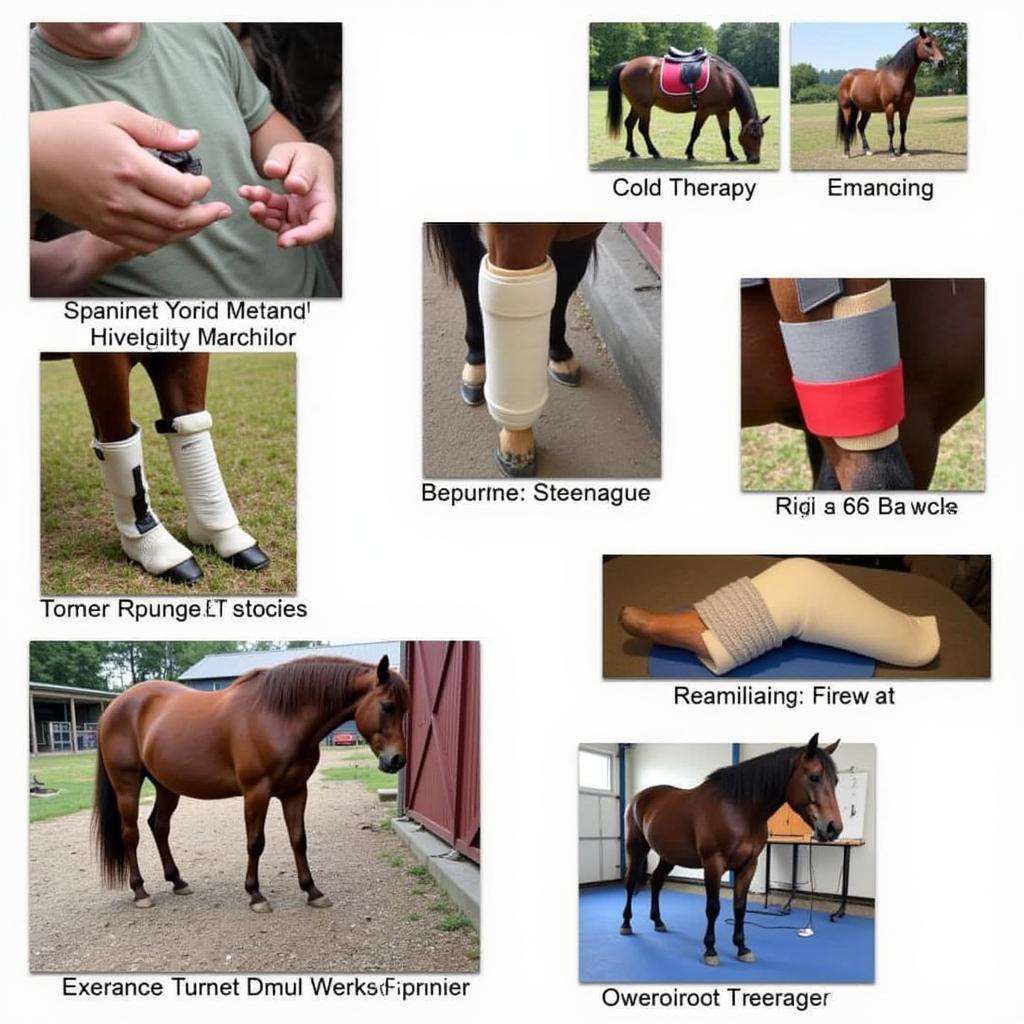A Sprained Fetlock Joint In Horses is a common injury that can range from mild to severe. Understanding the causes, symptoms, and treatment options is crucial for any horse owner. This guide provides an in-depth look at sprained fetlocks, equipping you with the knowledge to best care for your equine companion.
Understanding the Equine Fetlock Joint
The fetlock joint is equivalent to the ankle in humans and plays a vital role in a horse’s movement, absorbing a significant amount of impact with each stride. It’s a complex structure composed of bones, ligaments, tendons, and cartilage, making it susceptible to injury.
The Mechanics of a Sprain
A sprain occurs when the ligaments supporting the fetlock joint are stretched or torn, often due to overextension or twisting. The severity of the sprain is categorized into grades, ranging from a mild stretching (Grade 1) to a complete rupture (Grade 3).
Recognizing the Signs of a Sprained Fetlock
Recognizing the signs of a sprained fetlock is crucial for early intervention and effective treatment. Common symptoms include:
- Lameness: This can vary from mild to severe, with the horse exhibiting a noticeable limp.
- Swelling: The fetlock joint area will often appear swollen and inflamed.
- Heat: The affected area may feel warmer to the touch than the surrounding tissue.
- Pain: The horse may show signs of pain when the fetlock is touched or manipulated.
- Instability: In severe cases, the joint may appear unstable or wobbly.
What causes a sprained fetlock in horses? Overexertion, uneven footing, and trauma during activities like jumping or racing are common culprits.
How can you tell if a horse has a sprained fetlock? Look for lameness, swelling, heat, pain, and instability around the fetlock joint.
Diagnosis and Treatment of a Sprained Fetlock
Veterinary diagnosis is essential for confirming a sprained fetlock and determining the severity of the injury. Diagnostic methods include:
- Physical Examination: Your vet will assess the horse’s lameness, palpate the fetlock, and check for swelling, heat, and pain.
- Imaging: X-rays, ultrasounds, or MRI scans can help visualize the extent of ligament damage and rule out other potential injuries.
Treatment options vary depending on the severity of the sprain:
- Rest and Cold Therapy: Rest is crucial for healing, along with applying cold packs to reduce swelling and inflammation.
- Bandaging and Support: Supportive bandages or splints may be used to stabilize the joint and restrict movement.
- Medications: Non-steroidal anti-inflammatory drugs (NSAIDs) can help manage pain and inflammation.
- Rehabilitation: Controlled exercise and physical therapy are essential for restoring joint function and strength.
- Surgery: In severe cases involving ligament rupture, surgery may be required to repair the damage.
 Treatment and Recovery for a Horse with Sprained Fetlock
Treatment and Recovery for a Horse with Sprained Fetlock
“Early diagnosis and prompt treatment are key to a successful recovery from a sprained fetlock,” says Dr. Emily Carter, DVM, specializing in equine sports medicine. “Ignoring the signs can lead to chronic lameness and long-term complications.”
Preventing Fetlock Sprains
While not all sprains are preventable, certain measures can reduce the risk:
- Maintain good footing: Ensure paddocks and arenas are free from holes, debris, and uneven surfaces.
- Warm-up and cool-down: Proper warm-up and cool-down routines are essential before and after exercise.
- Appropriate exercise: Avoid overexerting your horse and gradually increase the intensity and duration of workouts.
- Corrective shoeing: Proper hoof care and corrective shoeing can improve balance and reduce stress on the fetlock joint.
“Preventive measures like maintaining good footing and implementing appropriate exercise routines can significantly reduce the incidence of fetlock sprains,” adds Dr. Carter. “Regular veterinary checkups are also vital for early detection of any potential issues.”
Conclusion
A sprained fetlock joint can be a significant setback for a horse, but with prompt diagnosis, appropriate treatment, and diligent rehabilitation, most horses can recover and return to their normal activities. By understanding the causes, symptoms, and treatment options, you can help ensure your horse’s well-being and longevity. Remember to always consult with your veterinarian for accurate diagnosis and personalized treatment plans.
FAQs
- How long does it take for a sprained fetlock to heal? Healing time varies depending on the severity of the sprain, ranging from a few weeks to several months.
- Can a horse with a sprained fetlock be ridden? Riding should be avoided until your veterinarian clears your horse for exercise.
- What are the long-term effects of a sprained fetlock? Untreated or poorly managed sprains can lead to chronic lameness, arthritis, and reduced performance.
- How can I prevent my horse from re-injuring its fetlock? Following your veterinarian’s rehabilitation plan, maintaining good footing, and avoiding overexertion are crucial for preventing re-injury.
- What are the different grades of fetlock sprains? Grade 1: Mild stretching of ligaments. Grade 2: Partial tearing of ligaments. Grade 3: Complete rupture of ligaments.
- Are certain breeds of horses more prone to fetlock sprains? Certain disciplines, such as racing and jumping, carry a higher risk of fetlock sprains due to the high impact nature of these activities.
- What should I do if I suspect my horse has a sprained fetlock? Contact your veterinarian immediately for an examination and diagnosis.
For further information on equine health and care, explore other articles on Justus Horses USA. We have resources on various topics, including lameness, first aid, and preventative care.
Need assistance? Contact us at Phone: 0772127271, Email: [email protected] or visit our location at QGM2+WX2, Vị Trung, Vị Thuỷ, Hậu Giang, Việt Nam. Our customer service team is available 24/7.